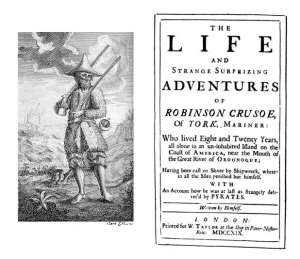Originally posted on Here Begynneth A Lytell Geste of Robin Hood….
The expiration of the Licensing Act in 1695, which had required the pre-publication censorship of all printed matter, led to an explosion of published works during the 18th century; books, periodicals, and pamphlets poured forth from the press in great abundance. One of the most enduring genres which emerged during this period, however, was the novel.
The first English novel is generally assumed to be Daniel Defoe’s Robinson Crusoe (1719). It had its roots in the romance genre which began on the continent with titles such as Don Quixote (1605, 1615), which usually took as their heroes members of the nobility acting within fantastical settings. Yet novels, in contrast, took for their subject real life, and usually purported to be the ‘life’ or ‘history’ of a real person, hence the full title of Defoe’s work, The Life and Strange Surprizing Adventures of Robinson Crusoe (1719). Their purpose was to provide entertainment and moral instruction to aspirant members of polite society, as Henry Fielding wrote in the preface to his novel, Joseph Andrews (1742):
Delight is mixed with Instruction…the Reader is almost as much improved as entertained.
Additionally, the novel also had roots in late 17th- and 18th-century criminal biography. Criminal biographies such as Alexander Smith’s A History of the Most Noted Highwaymen (1719), Charles Johnson’s Lives of the Most Remarkable Criminals (1735), and many other individual titles detailing the life of a condemned felon, sought to mix entertainment with moral instruction by presenting readers with…
via The Novel and 18th-Century Criminal Biography | Here Begynneth A Lytell Geste of Robin Hood….


A wonderful post….Thank you and have a lovely Thursday…keep smiling:)x
LikeLiked by 1 person
Thank you, Janet. I get such pleasure out of re-blogging something that others find interesting. Happy Thursday!
LikeLiked by 1 person
Fascinating stuff Sarah, thanks for finding and sharing! There’s outré friend Jonathan Wild again too 🙂
LikeLiked by 1 person
Pleasure to entertain you, Jane!
LikeLiked by 1 person
PS Do wish the auto spell thingy on my keyboard would stop altering my words – that should have been our – he may well have been outré too but I could have said that myself !!
LikeLiked by 1 person
I’m sure Wild would have been thrilled with ‘outré’. I would!
LikeLiked by 1 person
Fascinating content. Thanks Sarah
LikeLiked by 1 person
Great pleasure, Olga.
LikeLike